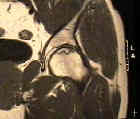- See:
- MRI of Hip:
- Johns Hopkins - MRI Evaluation of AVN
- Discussion:
- magnetic resonance imaging is probably the most accurate imaging modality for dx of AVN of femoral head;
- MRI imaging is also used to outline the area of involvement;
- it can show the revascularization front and provide objective evidence of changes in the tissue in response to treatment;
- it allows sequential evaluation of asymptomatic lesions that are not yet detectable on plain radiographs;

- Classic Findings:
- look for focal lesion in the anterosuperior portion of femoral head that is well demarcated but is inhomogeneous;
- T1 images:
- will show low signal intensity;
- T2 images:
- double line sign:
- classic sign of AVN;
- made up of 2 concentric low and high signal bands;
- the high-signal-intensity line may represent hypervascular granulation tissue;
- Diff Dx:
- bone marrow edema syndrome:
- ref: Bone-marrow oedema syndrome and transient osteoporosis of the hip. An MRI-controlled study of treatment by core decompression.
- transient regional osteoporosis:
- T1 images: pattern of diffusely decreased signal intensity;
- T2 images: high signal intensity which matches the T1 changes;
- False Negative Results:
- on rare occasions, investigators have found AVN on histological exam of specimens of bone when magnetic resonance imaging was
negative;
- Koo et al reported on a group of patients who had several risk factors for avascular necrosis;
- of 136 biopsy specimens that were consistent w/ avascular necrosis, ten were assoc w/ negative magnetic resonance images
The diagnostic value of magnetic resonance imaging in non-traumatic osteonecrosis of the femoral head.
Prediction of Collapse with Magnetic Resonance Imaging of Avascular Necrosis of the Femoral Head.
Histologic correlation in magnetic resonance imaging of femoral head osteonecrosis.
Histologic correlation in magnetic resonance imaging of femoral head osteonecrosis.


